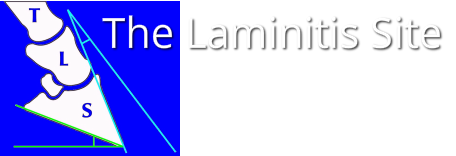Just a reminder that if a horse is showing signs of footiness/laminitis between Aug and Oct (in the northern hemisphere), particularly if for the first time or if older than 10 (although plenty of horses are diagnosed younger than this), and there hasn't been an obvious diet/management change that might bring on laminitis, PPID should be seriously considered and eliminated as the cause. ACTH testing is currently free in the UK (Sept - Nov 2013) - http://www.talkaboutlaminitis.co.uk/. Tests for PPID are often negative in the early stages of the disease, so be aware of the symptoms of PPID (see http://www.thelaminitissite.org/ppid.html and http://www.prascend.com/Content/PDF/BIVM-12015%20Prascend%20Diagnosis%20Booklet_WEB.pdf) and don't be afraid to ask for a trial of Pergolide - see Question 3 under Therapy - http://www.prascend.com/Veterinarian/VetFAQs:
"Question: When should horses be treated with PRASCEND?
Answer: A horse exhibiting clinical signs of PPID, including unexplained laminitic episodes, should undergo evaluation for PPID. A horse exhibiting clinical signs or that has positive results on ACTH or DST testing should be treated with PRASCEND. Currently available diagnostic tests are not sensitive in detection of early disease. Therefore, if test results are negative, but a high index of clinical suspicion exists that the horse suffers from PPID, a 6-month trial of PRASCEND may be instituted and response to treatment observed."
NB TLS does NOT advise the use of the dexamethasone suppression test - ever - because of the high risk of causing/exacerbating laminitis in horses that are insulin resistant, and it can't be used between Aug and Oct anyway. The basal ACTH test is the best test for PPID, possibly followed by the TRH stimulation of ACTH if a basal ACTH test is equivocal - although a trial of pergolide (Prascend) and clinical symptom response to treatment may be assumed to be diagnostic.
Despite what some vets are still saying, testing ACTH between Aug and Oct is the best time of year to test, when the difference between normal and PPID horses is more pronounced, as long as seasonally adjusted reference ranges are used. See: http://liphookequinehospital.co.uk/wp-content/uploads/Lab-Book-PPID.pdf. Interpretation of ACTH results is far from an exact science - as already mentioned, horses often test negative in the early stages of PPID, and clinical symptoms must be taken into account too. It is now thought that between Nov and July, although a cut-off of 29 pg/ml is often suggested, results below 20 pg/ml are likely to be negative for PPID, results over 40 pg/ml are likely to be positive for PPID, and horses with a result in the "grey area" between 20 and 40 pg/ml should have further testing (figures based on CIA testing using Immulite as used at Liphook Equine Hospital, other assays may require different interpretation) - see http://onlinelibrary.wiley.com/doi/10.1111/evj.12114/abstract. Between Aug and Oct the cut-off is 47 pg/ml, with the "grey area" likely to extend 10 pg/ml or so either side - so perhaps less than 37 pg/ml is likely to be negative for PPID, and more than 57 pg/ml likely to be positive, although we haven't seen these figures confirmed.
"Question: When should horses be treated with PRASCEND?
Answer: A horse exhibiting clinical signs of PPID, including unexplained laminitic episodes, should undergo evaluation for PPID. A horse exhibiting clinical signs or that has positive results on ACTH or DST testing should be treated with PRASCEND. Currently available diagnostic tests are not sensitive in detection of early disease. Therefore, if test results are negative, but a high index of clinical suspicion exists that the horse suffers from PPID, a 6-month trial of PRASCEND may be instituted and response to treatment observed."
NB TLS does NOT advise the use of the dexamethasone suppression test - ever - because of the high risk of causing/exacerbating laminitis in horses that are insulin resistant, and it can't be used between Aug and Oct anyway. The basal ACTH test is the best test for PPID, possibly followed by the TRH stimulation of ACTH if a basal ACTH test is equivocal - although a trial of pergolide (Prascend) and clinical symptom response to treatment may be assumed to be diagnostic.
Despite what some vets are still saying, testing ACTH between Aug and Oct is the best time of year to test, when the difference between normal and PPID horses is more pronounced, as long as seasonally adjusted reference ranges are used. See: http://liphookequinehospital.co.uk/wp-content/uploads/Lab-Book-PPID.pdf. Interpretation of ACTH results is far from an exact science - as already mentioned, horses often test negative in the early stages of PPID, and clinical symptoms must be taken into account too. It is now thought that between Nov and July, although a cut-off of 29 pg/ml is often suggested, results below 20 pg/ml are likely to be negative for PPID, results over 40 pg/ml are likely to be positive for PPID, and horses with a result in the "grey area" between 20 and 40 pg/ml should have further testing (figures based on CIA testing using Immulite as used at Liphook Equine Hospital, other assays may require different interpretation) - see http://onlinelibrary.wiley.com/doi/10.1111/evj.12114/abstract. Between Aug and Oct the cut-off is 47 pg/ml, with the "grey area" likely to extend 10 pg/ml or so either side - so perhaps less than 37 pg/ml is likely to be negative for PPID, and more than 57 pg/ml likely to be positive, although we haven't seen these figures confirmed.

 RSS Feed
RSS Feed